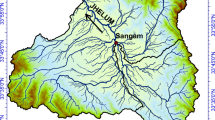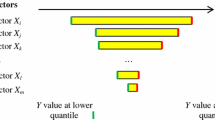Abstract
Recently, the New Morris Method has been presented as an effective sensitivity analysis tool for mathematical models. The New Morris Method estimates the sensitivity of an output parameter to a given set of input parameters (first-order effects) and the extent these parameters interact with each other (second-order effects). This method requires the specification of two parameters (runs and resolution) that control the sampling of the output parameter to determine its sensitivity to various inputs. The criteria for these parameters have been set on the analysis of a well-behaved analytical function (see Cropp and Braddock, Reliab. Eng. Syst. Saf. 78:77–83, 2002), which may not be applicable to other physical models that describe complex processes. This paper will investigate the appropriateness of the criteria from (Cropp and Braddock, 2002) and hence the effectiveness of the New Morris Method to determine the sensitivity behaviour of two hydrologic models: the Soil Erosion and Deposition System and Griffith University Representation of Urban Hydrology. In the first case, this paper will separately analyse the sensitivity of an output parameter on a set of input parameters (first- and second-order effects) for each model and discuss the physical meaning of these sensitivities. This will be followed by an investigation into the sampling criteria by exploring the convergence of the sensitivity behaviour for each model as the sampling of the parameter space is increased. By comparing these trends to the convergence behaviour from Cropp and Braddock (2002), we will determine how well the New Morris Method estimates the sensitivity for each model and whether the sampling criteria are appropriate for these models. It will be shown that the New Morris Method can provide additional insight into the functioning of these models, and that, under a different metric, the sensitivity behaviour of these models does converge confirming the sampling criteria set by Cropp and Braddock.
Similar content being viewed by others
References
Bluman, A. G. (2001). Elementary statistics. New York: McGraw-Hill.
Boughton, W. C. (1993). In Proc. 1993 Hydrology and Water Resources Conference, IEAust, Canberra, Nat. Conf. Pub. No. 93/14, pp. 317–324.
Boyd, M. J., Bufill, M. C., & Knee, R. M. (1993). Hydrological Sciences Journal, 38, 463–478.
Braddock, R. D., & Schreider, S. (2005). Environmental Modelling and Assessment, (in press).
Capolongo, F. (1998). Doctoral Thesis, Griffith University, Australia.
Capolongo, F., & Braddock, R. D. (1999). Reliability Engineering and System Safety, 64, 1–12.
Chiew, F. H. S., & McMahon, T. A. (1999). Water Science & Technology, 39(12), 241–248.
Cropp, R. A., & Braddock, R. D. (2002). Reliability Engineering and System Safety, 78, 77–83.
Ghadiri, H., & Rose, C. W. (1991). Journal of Environmental Quality, 20, 628–633.
Hairsine, P. B., Beuselinck, L., & Sander, G. C. (2002). Water Resources Research, 38(6), Art No. 1086 Jun.
Hairsine, P. B., & Rose, C. W. (1992). Water Resources Research, 28, 237–243.
Heilig, G. C., DeBruyn, D., Walter, M. T., Rose, C. W., Parlange, J.-Y., Steenhuis, T. S., Sander, G. C., Hairsine, P. B., Hogarth, W. L., & Walker, L. P. (2001). Journal of Hydrology, 244, 9–16.
Huang, C., Wells L. K., & Norton, L. D. (1999). Earth Surface Processes and Landform, 24, 503–516.
Misra, R. K., & Rose, C. W. (1996). European Journal of Soil Science, 47, 593–604.
Morris, M. D. (1991). Technometrics, 33, 161–174.
Mullins, B. J., Agranovski, I. E., & Braddock, R. D. (2004). Journal of Colloid and Interface Science, 269(2), 449–458.
Newton, D. B., Jenkins, G. A., & Yu, B. (2006). Journal of Hydrologic Engineering ASCE, in prep.
Rose, C. W., Coughlan, K. J., Ciesiolka, C. A., & Fentie, B. (1997). In K. J. Coughlan & C. W. Rose (Eds.), A new soil conservation methodology and application to cropping systems in tropical steeplands (pp. 34–58), ACIAR Technical Report, No. 40, Canberra.
Sander, G. C., Hairsine, P. B., Beuselinck, L., & Govers, G. (2002). Water Resources Research, 38(6), Art No. 1087 Jun.
Whitcombe, J. M., Cropp, R. A., Braddock, R. D., & Agranovski, I. E. (2003). Reliability Engineering and System Safety, 79, 219–224.
Yu, B., & Rose, C. W. (1999). Australian Journal of Soil Research, 37, 1–11.
Yu, B., Sajjapongse, A., Yin, D., Eusof, Z., Anecksamphant, C., Rose, C. W., & Cakurs, U. (1999). Australian Journal of Soil Research, 37, 13–31.
Author information
Authors and Affiliations
Corresponding author
Rights and permissions
About this article
Cite this article
Matthews, C.J., Newton, D.B., Braddock, R.D. et al. Analysing the sensitivity behaviour of two hydrology models. Environ Model Assess 12, 27–41 (2007). https://doi.org/10.1007/s10666-006-9049-3
Received:
Accepted:
Published:
Issue Date:
DOI: https://doi.org/10.1007/s10666-006-9049-3




